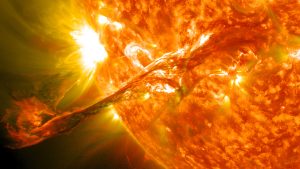
Despite expert predictions for a period of prolonged quiet for the Sun, solar cycle 25 has proven to be an active one, with 143 sunspots appearing on the Sun’s surface during February alone, and numerous solar flares erupting from the star’s surface—15 of them powerful X-class events—since the current cycle started in December 2019.
One thing to bear in mind, however, is that despite the marked increase in solar activity over the past few years, solar cycle 25’s activity is actually rather average, similar to an output level recorded during solar cycle 23, between August 1996 and December 2008; however, this renewed activity is a marked change from the relatively peaceful cycle 24 that led many solar experts to believe that the Sun may be entering a longer period of inactivity similar to the Maunder Minimum that lasted from 1645 to 1715.
Instead, the Sun sprung back to life, resuming its typical routine of sunspot formation, solar flares and coronal mass ejections (CME); the increased activity for this cycle was only predicted by a pair of renegade solar physicists from the University of Maryland, who, instead of relying on sunspot numbers as a predictive model for solar activity, looked for patterns in what they called “termination events” of the magnetic bands that meet at the Sun’s equator during the change of solar cycles.
A recent example of a “strong” X-class flare that occurred on March 3, when an X2.1 flare caused disruptions to high -frequency radio transmissions on Earth’s sunlit side. X-class flares are the strongest solar eruptions, coming after A, B, C and M on the soft X-ray classification scale; the strongest so far this cycle was an X2.2 that occurred on April 20, 2022. However, as X-class eruptions go, these bursts were rather moderate, as the scale ranges from X1 up to a potentially devastating X10.
Numerous geomagnetic storms have also occurred, the result of the charged particles released during a CME interacting with our planet’s magnetic field, events that can disrupt radio communications, and if strong enough can have a widespread EMP-like effect that can disrupt the functioning of electronic equipment. Thankfully, only one geomagnetic storm exceeded M2 on the K-index (ranging between M1 and M5), with an M4 occurring over the course of November 3 and 4.
This isn’t to say that this renewed—albeit moderate—solar activity can’t present a danger to humanity: the most intense geomagnetic storm in recorded history, the 1859 Carrington Event, occurred during the otherwise-average solar cycle 10, an event that, if it were to happen today, would be devastating to our modern electrical grid. Whitley outlines the danger presented by solar storms of that magnitude—and what needs to be done to weather such a storm—in his 2012 ebook Solar Flares: What You Need to Know.
Subscribers, to watch the subscriber version of the video, first log in then click on Dreamland Subscriber-Only Video Podcast link.
Charlemagne solar flare: In the year 774 AD, an enormously powerful blast of matter and energy from space slammed into Earth.
—
Melott said. “We just observed this simple mistake and corrected it, and the answer came out that it would be 10 or 20 times greater than the Carrington event in 1859. That means that this may be a more reasonable explanation. The Carrington event is the greatest in the last 200 years, and this would be the greatest thing in the last 1,300 years or so, so it becomes more reasonable.” ( https://phys.org/news/2012-11-sun-source-eighth-century-charlemagne-event.html )
Love these Solar Flare updates, Whitley! Do you think the flares are because we are getting pushed into a new density orrr because of Global Warming? Or maybe both?
Also, I hope you are doing awesome in your recovery from your surgery! <3
This amount of activity is actually a sort-of return to normal, the Sun just seems like it’s overactive because the last cycle was such a dud. It’s basically just the Sun being the Sun.
However, despite the Sun’s current activity being described as being like it was around the turn of the millennium (cycle 23), this is actually still somewhat below normal in regards to long-term trends, since solar activity has been on a steady decline since its most recent peak in the 1950s.